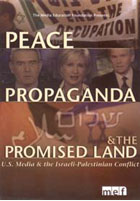
Peace, Propaganda & The Promised Land: U.S. Media & the Israeli-Palestinian Conflict 2004
Distributed by Arab Film Distribution, 10035 35th Ave. NE, Seattle, WA 98125; 206-322-0882
Produced by Bathsheba Ratzkoff & Sut Jhally
Directed by Bathsheba Ratzkoff & Sut Jhally
VHS, color, 80 min.
College - Adult
Communication, Human Rights, Journalism, Media Studies, Middle Eastern Studies, Political Science
Date Entered: 03/22/2006
Reviewed by Jack DeMasi, Prof., Communications Dept., Nassau Community College, Garden City, New YorkThe Middle East proves the adage about truth being the first casualty of war. No doubt everyone, regardless of race, creed or political stripe, has strong – and often opposing - opinions about the very nature of the various conflicts there, as well as what the desired outcomes should be and what the best means would be for obtaining those outcomes. No doubt also that all those ideas and opinions depend fully upon the very faulty process of newsgathering and dissemination which obfuscates and alters even perceived truth in the service of forces whose needs lie far outside the need for a properly informed public.
Peace, Propaganda and the Promised Land: U.S. Media and the Israeli-Palestinian Conflict lays bare, in no couched terms, the nature of one of those myriad conflicts. Producers Bathsheba Ratzkoff and Sut Jhally have created a scathing analysis of the methods which they claim Israel has used both to shape world - and most especially American - opinion about their ongoing occupation of Palestinian land and to obscure journalistic efforts to penetrate their agenda.
The film’s documentary style employs scenes of graphic physical violence and just as graphic psychological violence to illustrate the Palestinian plight under Israeli domination: endless delays and bullying at checkpoints, men taken off and beaten by soldiers for no apparent reason, women insulted and intimidated, the wanton destruction of homes and olive groves. Additionally, charts and maps make plain the realities of the situation by illustrating the ways in which Palestinian land has been carved up among the settlements and the ways in which one of the proposed peace plans did nothing to improve the situation. However, the technique that carries the most intellectual weight is the interview. The cast includes the ubiquitous MIT Professor Noam Chomsky, journalists Alisa Solomon and Robert Fisk, Seth Ackerman of Fairness and Accuracy in Reporting, Israeli Army Major Stav Adivi, Rabbi Arik Ascherman of Israel’s Rabbis for Human Rights and Rabbi Michael Lerner of Tikkun Magazine, to name only a few of the multitude of Israeli, American and Palestinian journalists, human rights activists and interest group spokespersons.
Of course, the endless, possibly specious, changes in the Israeli-Palestinian situation as well as the death of Arafat, the ascent of Hamas and the dismantling of some settlements render the film vulnerable to becoming dated and, perhaps less useful, for political and historical study. However, its formidable strength lies in its analysis of the mechanisms and techniques by which a country – or any large corporation for that matter – can manipulate the large corporate media for its own ends – at the expense of the truth. It demonstrates that much of what we believe is a mediated reality that does not permit us the luxury of well-informed opinions.
The film’s careful delineation and intense analysis of issues makes it a provocative tool for the stimulation of discussion and an excellent addition to media collections, simply because of its out-of-the-mainstream point of view. Unfortunately, the film’s strident and clearly anti-Israeli tone makes it difficult to use in most situations. Peace, Propaganda and the Promised Land is recommended in controlled teaching situations for college level students of political science, history and Middle Eastern studies. It is highly recommended for college students of mass communications and journalism.